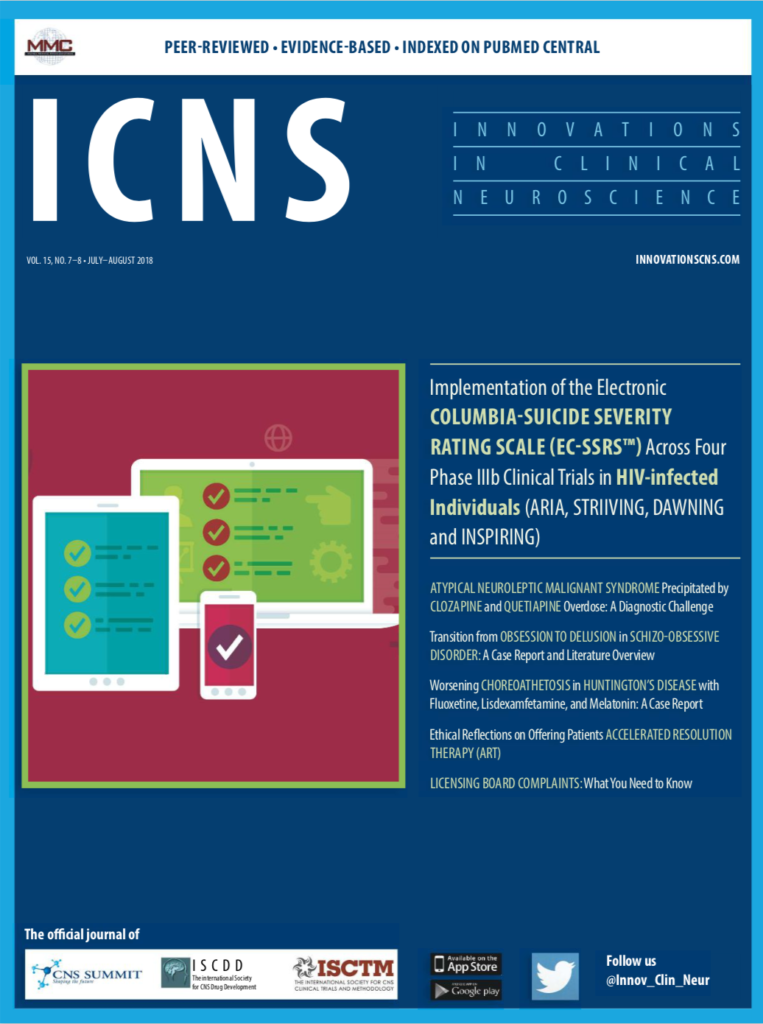 Dear Colleagues:
Dear Colleagues:
Welcome to the July–August 2018 issue of Innovations in Clinical Neuroscience (ICNS). We start this issue with a report by Brennan et al titled, “Implementation of the Electronic Columbia-Suicide Severity Rating Scale (eCSSRS™) Across Four Phase IIIb Clinical Trials in HIV-infected Individuals (ARIA, STRIIVING, DAWNING and INSPIRING).” Here, researchers assessed site perspectives on implementation of the eC-SSRS, which was used in Phase IIIb studies of dolutegravir.
Next, in a case report by Teo et al titled, “Atypical Neuroleptic Malignant Syndrome (NMS) Precipitated by Clozapine and Quetiapine Overdose: A Diagnostic Challenge,” the authors describe the case of a 43-year-old man with a history of treatment-resistant schizophrenia, diabetes mellitus, and hypertension who overdosed on his medications, including clozapine, quetiapine and venlafaxine. The patient met some but not all of the typical diagnostic criteria for NMS; however, his extremely high serum creatine kinase levels, among other factors, led to the diagnosis of an atypical form of NMS. The authors describe the patient’s treatment plan, discuss signs, symptoms, and causes of NMS, and review treatment options.
Following this, Scotti-Muzzi and Saide present their case report titled, “Transition from Obsession to Delusion in Schizo-obsessive Disorder: A Case Report and Literature Overview.” Here, the authors describe the case of a young man who experienced intermittent symptoms of obsessive-compulsive disorder (OCD) and symptoms of schizophrenia over the course of several years. The authors report that the patient’s obsessive egodystonic ideation eventually transitioned to delusional egosyntonic and over-valued ideation. The authors describe and discuss the patient’s disease progression and treatment, propose diagnoses, and discuss the longitudinal dynamics between OCD and schizophrenia— in particular, schizo-obsessive disorder.
Next, in a case report titled, “Worsening Choreoathetosis in Huntington’s Disease (HD) with Fluoxetine, Lisdexamfetamine, and Melatonin: A Case Report,”Hamilton et al present the case of a 52-year-old man with previously undiagnosed HD who exhibited significant choreoathetoid movements believed to be associated with fluoxetine and lisdexamfetamine. The authors describe the patient’s treatment regimen and provide a literature review discussing the adverse drug events of these medications and their mechanisms regarding dopaminergic modulation in early-middle stages of HD.
Following this, Howe et al present a commentary titled, “Ethical Reflections on Offering Patients Accelerated Resolution Therapy (ART).” Here, the authors briefly describe ART, which is an emerging therapy for post-traumatic stress disorder (PTSD), and review its positive, but limited, data. The authors then delve in ethical issues clinicians should consider before recommending ART to their patients. In the end, the authors conclude that “based on the moral principle of beneficence—helping their patients—and respecting patient autonomy,” providing information to patients with PTSD on ART-based therapy would be an ethically sound decision, despite the limited available data supporting its use among this patient population.
And finally, in this month’s Risk Management column, “Licensing Board Complaints: What You Need to Know,” McNary tackles some of the legal issues clinicians might face when complaints against them are filed with their licensing board. The author also provides a list of risk management suggestions on how to minimize the risk of licensing board complaints, ultimately concluding that “… the best risk management tool is to focus on providing optimal care to your patients, which includes clear communication and managing expectations.”
We hope you enjoy this issue of ICNS. As always, we welcome your submissions and feedback.
Sincerely

Amir Kalali, MD
Editor, Innovations in Clinical Neuroscience





